12 Types of Black Birds in Delaware (With Pictures)
Last Updated on
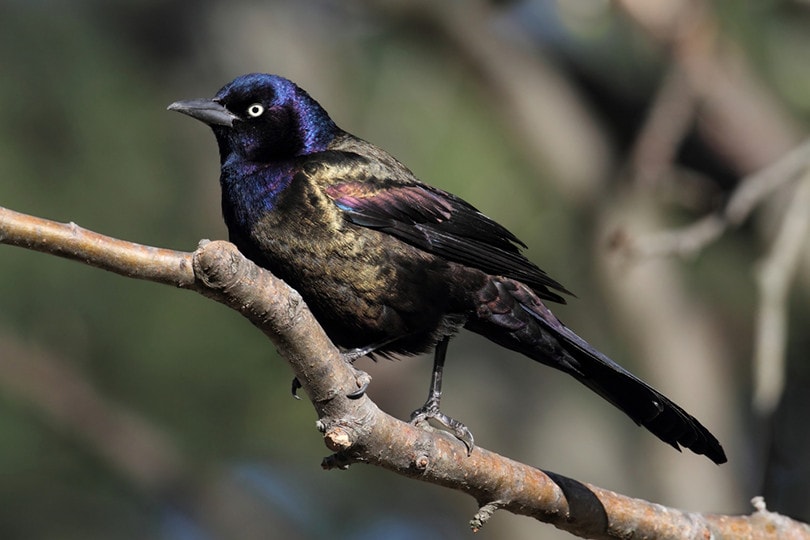
Delaware is a state that isn’t known for its wildlife but rather for its history in founding the USA. However, there’s more than meets the eye—there are a ton of bird species that lie in its domain, and black birds are no exception.
Today, we’ll be going over 12 types of black birds in Delaware in addition to some handy photos to help you with identification!

The 12 Types of Black Birds in Delaware
1. Baltimore Oriole

| Scientific name: | Icterus galbula |
| Family: | Icteridae |
| Endangerment: | Stable |
Since Delaware neighbors Maryland, it’s only natural that their state bird shares a home next door. Male Baltimore orioles have a sleek black back contrasted with a bright orange front. Their carnivorous diet consists of leaf-eating insects, while they live close by up in the trees. Orioles have a clear, airy call that can be heard from afar, but you can best hear them during mating season. Luckily, this is the time of year that they come around in Delaware!
2. European Starling
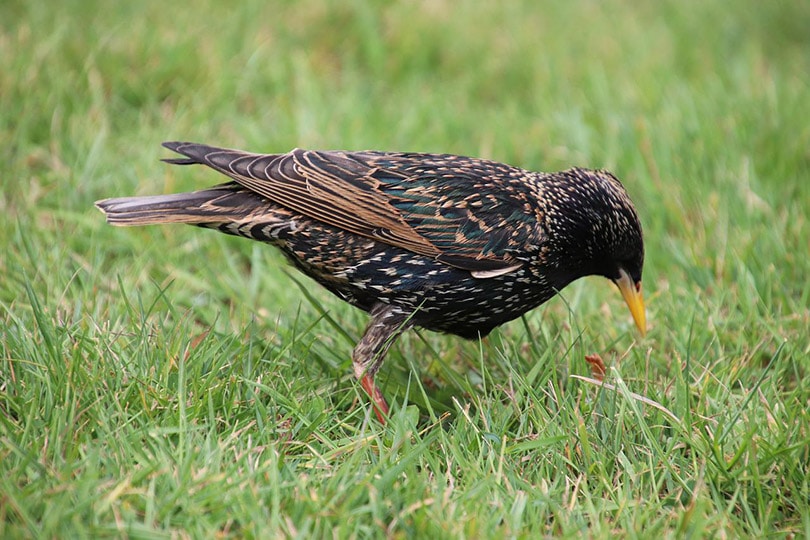
| Scientific name: | Sturnus vulgaris |
| Family: | Sturnidae |
| Endangerment: | Stable |
This year-round Delaware resident is a frequent bird found across the United States. You can find them pretty much anywhere, but they congregate in parks and residential areas quite often to scavenge for lawn-dwelling bugs. Both genders of the European starling have a black coat that’s mixed with various other colors, such as green, purple, and blue, but males are a bit darker. Starlings are known as pest birds though, so do keep that in mind.
3. Brown-Headed Cowbird
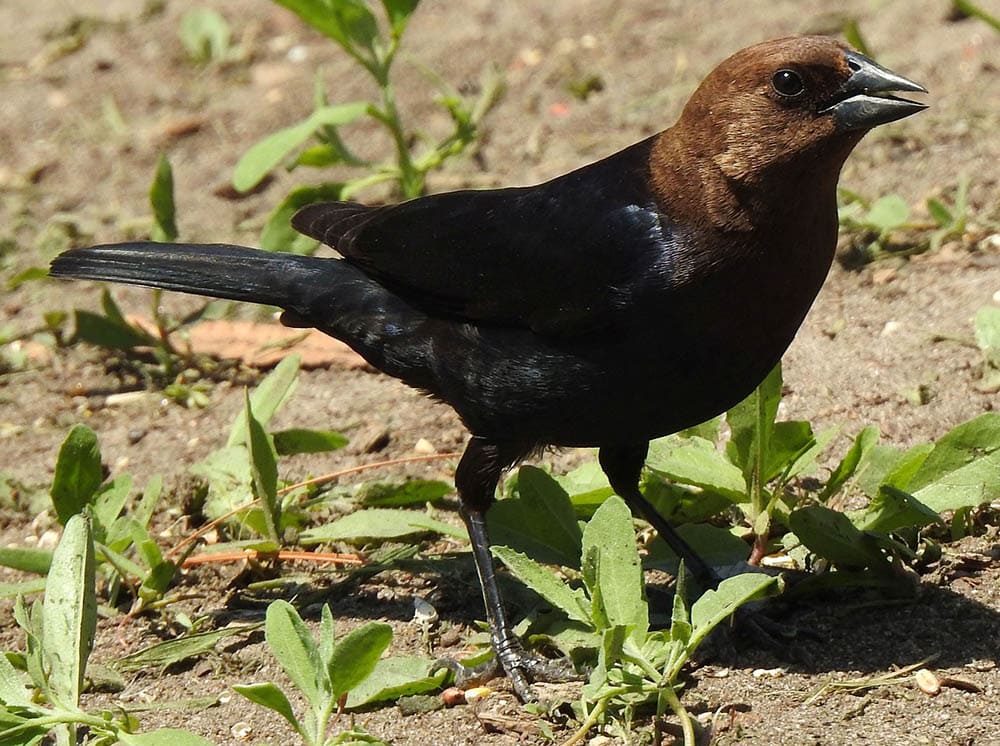
| Scientific name: | Molothrus ater |
| Family: | Icteridae |
| Endangerment: | Stable |
The brown-headed cowbird might have a brown head, but the rest of its body is full-on black. This is only the case for males, though, as females have grayish-brown plumage. This species of cowbird lives in grassy areas throughout the entire year in Delaware. They feed on seeds that drop below their grassy habitat but have started to make their way into forested areas. Brown-headed cowbirds tend to bother other bird species, which is in part due to their territorial behavior.
4. Bobolink

| Scientific name: | Dolichonyx oryzivorus |
| Family: | Icteridae |
| Endangerment: | Unstable |
The male bobolink has a mostly black body, but it stands out from other black birds because of the light-yellow color pattern behind its head. Bobolinks are a rare sight among many other birds on our list, but they are sought after by many birdwatchers because of their population decline. Generally speaking, this species only lives in Delaware during its breeding season and migrates to the tropics once that period is over. This is the best time to see them with their black coat, as they lose their black luster out of season. If you want to find them, they can be found in grassy areas where they nest and forage.
5. Rusty Blackbird
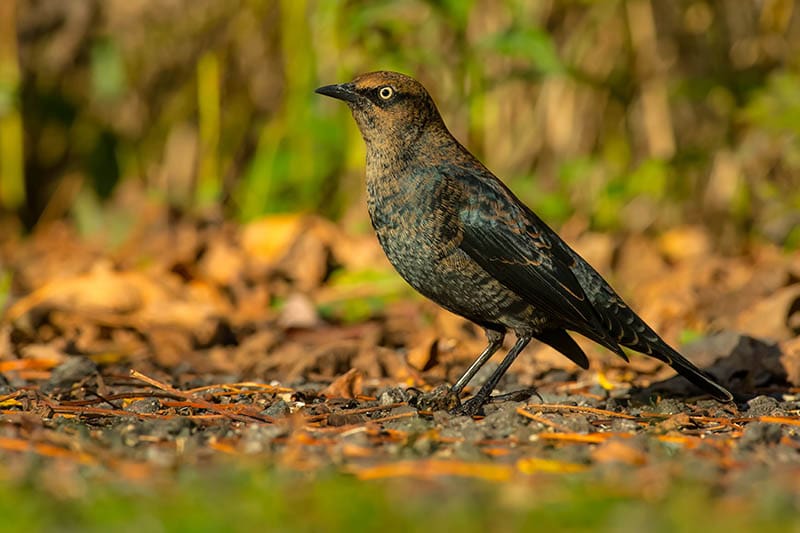
| Scientific name: | Euphagus carolinus |
| Family: | Icteridae |
| Endangerment: | Unstable |
Rusty blackbirds have a fitting name due to their mix of rust-colored and black feathers. This is especially the case for males, but to see them during the breeding season will give you the best black bird experience out there. They change to a completely jet-black coat! Unfortunately, their stay in Delaware is mostly limited to non-breeding periods and their population is decreasing rapidly. If you do manage to find them hidden in the woods, you may be able to catch them foraging for ground-level insects.
6. Boat-Tailed Grackle

| Scientific name: | Quiscalus major |
| Family: | Icteridae |
| Endangerment: | Stable |
An adult male boat-tailed grackle boasts a black plumage with subtle oily colors that shine in the light. Despite being a grackle, they are most commonly found on the Atlantic coast and can be seen eating oceanic fish. Their marshland territory makes them a natural ground-forager, but they keep their nests up high in nearby trees to hide from larger birds. You can find them pretty much any time of year – but you’ll have even more luck if you check fishing spots where they scavenge frequently.
7. Red-Winged Blackbird
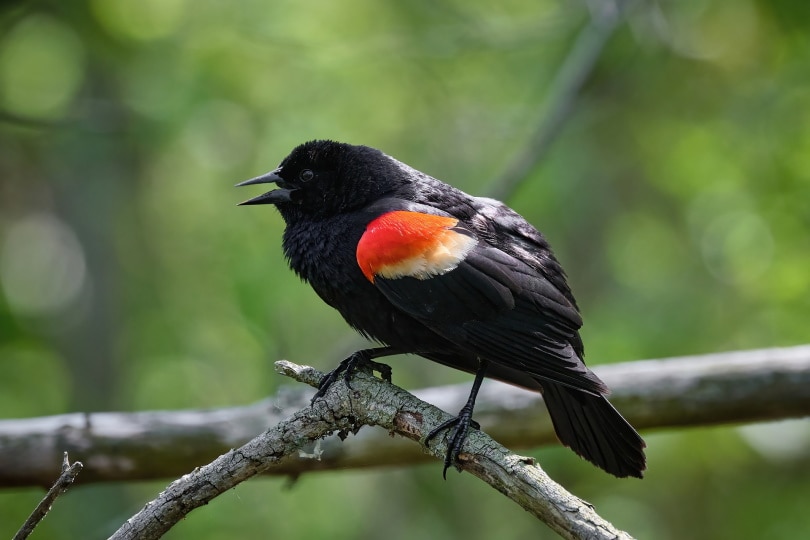
| Scientific name: | Agelaius phoeniceus |
| Family: | Icteridae |
| Endangerment: | Stable |
The red-winged blackbird is seen across the United States and is always an eye-catcher. Their striking red and yellow wing patterns stand out from their all-black body. You’ll see this when males are breeding during the springtime and they tend to be quite vocal. This blackbird species lives in wetland areas, like marshlands, ponds, parks, and more. They eat a carnivorous diet and are ground foragers. Most of the time, you can see them perched up high, although they do nest down low.
8. Common Raven
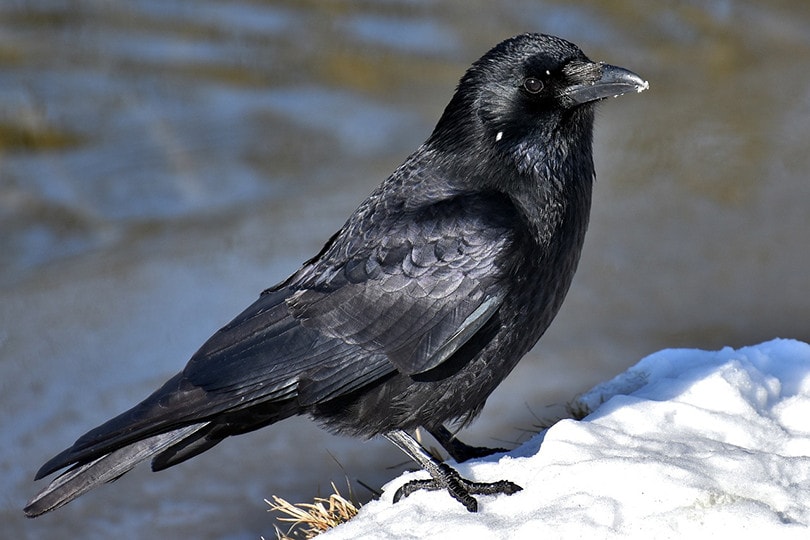
| Scientific name: | Corvus corax |
| Family: | Corvidae |
| Endangerment: | Stable |
Ravens aren’t particularly common in Delaware; however, you may be able to catch them on the western side of the state. They are a classic blackbird and have a notorious behavior of hacking and cawing near civilization while also being known for their roadkill scavenging. They’re easy to pick out from most other black birds because of their large size, but they are commonly mistaken for the American crow due to their physical and behavioral similarities.
9. Orchard Oriole
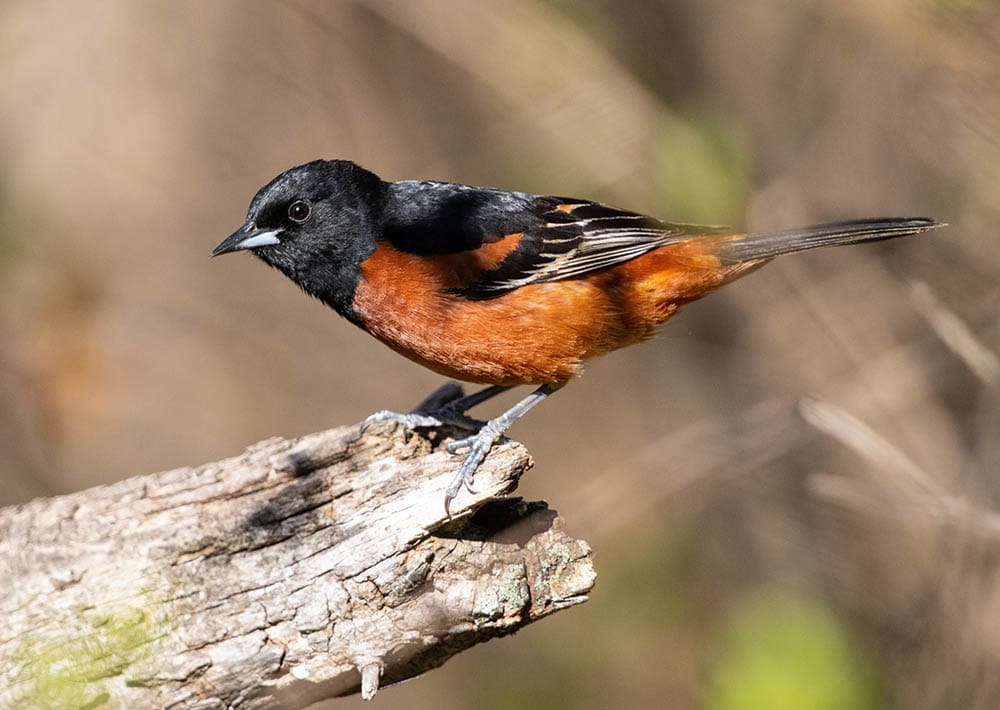
| Scientific name: | Icterus spurius |
| Family: | Icteridae |
| Endangerment: | Stable |
An open woodland-dweller, the male orchard oriole has an orange and black coat similar to the Baltimore oriole, except their orange hue is much less vibrant. Orchard orioles live throughout the eastern U.S, and they are easiest to find when spring comes around. They can live all the way down in South America when it gets cold, but when they find their way up north, their calls will be heard most frequently when the males are attempting to attract a mate.
10. Black Rail

| Scientific name: | Laterallus jamaicensis |
| Family: | Rallidae |
| Endangerment: | Very unstable |
Native to the east coast, the black rail is an extremely rare species due to habitat loss. They hide from humans incredibly well, so they are a challenging species to seek out. Your best bet is to stroll along the marshes of Delaware and catch them off-guard when they are probing for ocean critters. They stay hidden near the ground where they can slip away in the tall grass, so you might not have long to view them. Male and female black rails have a similar physical appearance, which is a blackish brown coat with white dots throughout.
11. Common Grackle
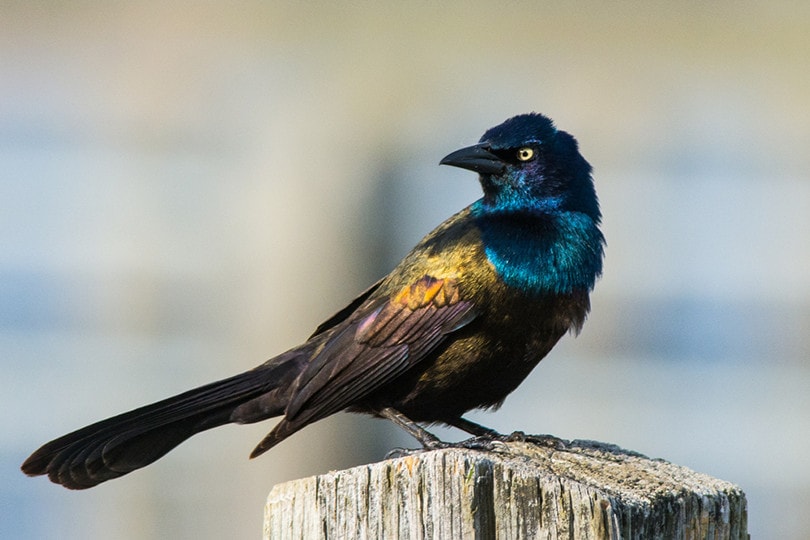
| Scientific name: | Quiscalus quiscula |
| Family: | Icteridae |
| Endangerment: | Unstable |
As the second grackle species on our list, the common grackle is not as common as it used to be. Due to their pesky reputation, they’ve been a target for many animal control operations. Delaware residents and visitors can still come across these omnivorous birds daily, whether at the park or on a commute to work. Unlike other black birds on our list, the female has the upper hand in this case; they have an all-black coat whereas male grackles have a tinted green color on their head.
12. American Crow
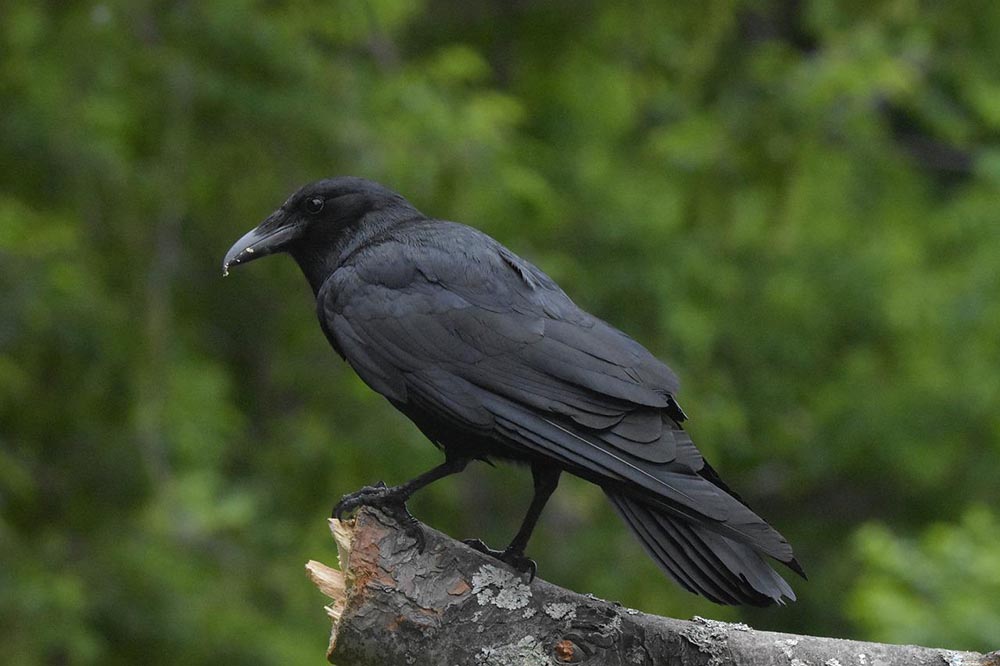
| Scientific name: | Corvus brachyrhynchos |
| Family: | Corvidae |
| Endangerment: | Stable |
At the end of the list is the well-established American crow, one of the most common birds in the country (and of North America). Crows are effortlessly recognized by their roadside shenanigans, sky-circling behaviors, and overall intelligence. In fact, their smarts are seen through their companionship, as they get together to find warmth during the colder months. It’s almost impossible not to see them every day due to their population dominance and all-season residency. Although, we’re guessing you already knew we’d mention this iconic aerial figure!

Final Thoughts
Despite the state’s small size, Delaware has a considerable population of birds. With both coastal and inland habitats, there is a great diversity of black birds in this region. If you’re in the area or want to visit someday, you’ve got to grab some binoculars or a spotting scope and see what the First State has to offer. We hope you enjoyed skimming through our list of 12 types of black birds in Delaware. Happy birdwatching!
Check out more black birds here:
Featured Image Credit: Steve Byland, Shutterstock
About the Author Robert Sparks
Robert’s obsession with all things optical started early in life, when his optician father would bring home prototypes for Robert to play with. Nowadays, Robert is dedicated to helping others find the right optics for their needs. His hobbies include astronomy, astrophysics, and model building. Originally from Newark, NJ, he resides in Santa Fe, New Mexico, where the nighttime skies are filled with glittering stars.
Related Articles:
Monocular vs Telescope: Differences Explained (With Pictures)
10 Types of Hummingbirds in Arkansas (With Pictures)
8 Types of Hummingbirds in Nebraska (With Pictures)
5 Types of Hummingbirds in Idaho (With Pictures)
3 Types of Hummingbirds in Mississippi (With Pictures)
8 Types of Hummingbirds in Kansas (With Pictures)
5 Types of Hummingbirds in West Virginia (With Pictures)
5 Types of Hummingbirds in Ohio (With Pictures)
